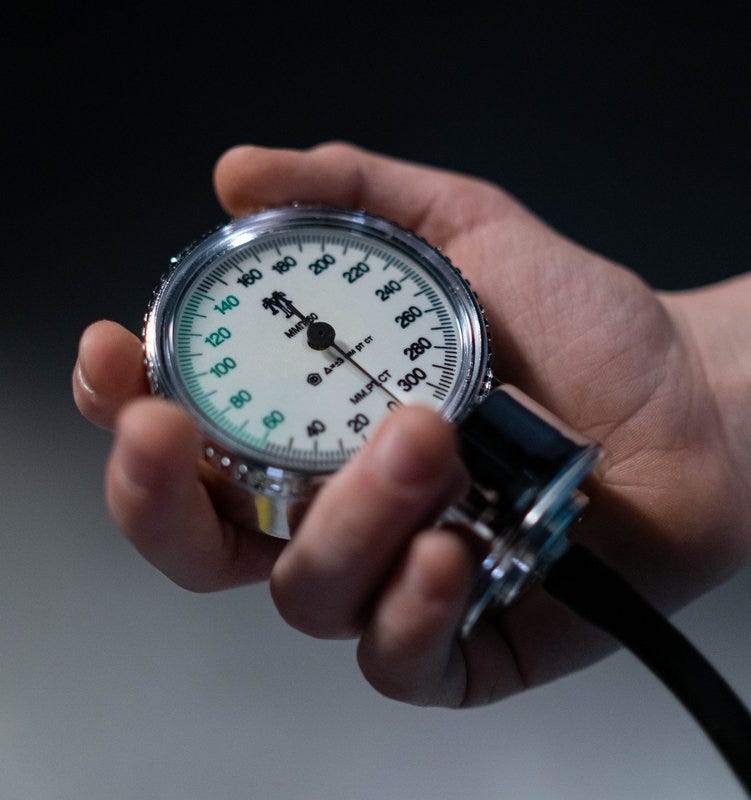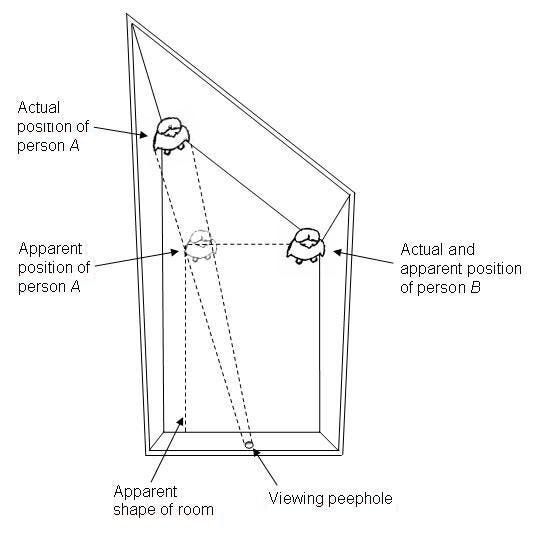A Room With An Impossible View (Redux)
"Wait, that pen is doing WHAT?"
Hello! This is Everything Is Amazing, a newsletter about science, curiosity, attention, and wonder.
First, a quick State Of The Newsletter update! Or rather, the State Of The Person Writing It.
For the last few years, I’ve been getting a lot of headaches. I’ve had migraines all my life, of the dramatic variety that would knock me flat for a few days every year. But from late last year, my headaches became weekly - and then, in some form or another, almost daily. This increasingly impacted my ability to stare at my laptop screen and get this ‘ere newsletter out the door in a timely fashion - and I also started getting them after any form of exercise (aka “exertion headaches,” which is a thing I believe I’ve Googled more than anyone on this planet).
Last week, with the help of medical professionals, I finally got to the bottom of it. It’s my blood pressure - seemingly with no underlying cause apart from general wear & tear, plus my own low-quality methods of managing everyday stress - and I’m delighted to report that after a week on some mild medication, the headaches have completely vanished. Fingers crossed!
One of those medical experts was my better half,
, a doctor (MD) now writing on Substack at and - ironically/hilariously enough - she’s just wrapping up a free course on managing stress:So, three things:
THANKS, MARIANA. Eeeesh.
Phew, and hooray! On we go.
Regularly tracking your blood pressure is a very wise thing, especially if you’re getting headaches. Please get it checked properly.
So, a short-term consequence of all this: I’m a little behind with the first piece for paid subscribers on this season-long investigation into human memory.
As I said back in July, this is the game that will be afoot:
“I want to find some ways to store things away in my brain in a form I’m much more confident of being able to retrieve later.
I want to know a few tricks for remembering what I want to remember, to curate my memories instead of taking enormous cognitive gulps of what’s around me at the time, like a photograph compared with a detailed sketch. (When I was an archaeologist, we learned to photograph and draw everything, because the latter is more of an argument about what you’re looking at, filtered through your interpretative skill.)
And of course, I want to find stuff that makes my inner child go WOW, all this new science is so cool. I’m tediously predictable like that. You know this, of course.”
So that first part is coming shortly. But not today!
In its place, and as a prelude to a story update that’s coming later this week, I’m rerunning the following piece from season 3 which features the most mind-blowing visual illusion I’ve ever seen.
I’ll explain exactly how the illusion works - but it won’t make the slightest difference. It will keep fooling you for the rest of your life every time you see it, without fail. That’s why I love it so much. It cannot be beat.
OK. Let’s do this.
It must be really hard being a scientist.
Publicly, I mean. In the sense of explaining what you do to others. Because if Google Image Search can be taken as the canary down our cultural coal-mine, scientists have a severe PR problem.
Here’s what came up when I typed in “scientist”:
(If you can’t see it, the first image is labelled “Image Gallery Of Mad Scientist Pictures.”)
We can probably blame Mary Shelley, HG Wells and Fritz Lang for the stock character of Mad Scientist - but after a century of having radio serials and B-movies hammering it home again and again, it’s ingrained into our collective memory: Scientist = Dangerous Antisocial Weirdo.
Introduce yourself as a scientist at a social gathering and you’ll be the butt of at least one lame joke involving test-tubes, flux capacitors and reanimated corpses. (And if you’re really unlucky, that’ll trigger some “serious” questions, like, “But hey, let’s get real for a minute - isn’t it like super-unethical for you people to bring the dead back to life, yeah? So why do you do it?”)
All that’s bad enough. But let’s think of the science-kids.
Any time that Hollywood has to depict a scientist as a child, it draws on another hapless cliché: the Pathetic Dork. There are the Gary-Larson-style spectacles, with lenses thicker than the bottoms of Coke bottles. There’s the astonishingly bad hair. There’s the awkwardness in social situations. There’s the hilariously dangerous invention they’re building in the basement, complete with the twin-lightning-pole things with a spark crawling upwards making a GZZZT sound (you know the ones - whatever they’re called) and some madly bubbling jar of floodlit green liquid, within which something is starting to twitch…
Is this stereotype having a damaging effect?
Oh, you bet it is.
So how do scientists actually get started in the real world? Oh lordy. You might as well ask What does a cloud look like? The most common entry-point is & always was the flourishing of raw curiosity - the kind displayed by Ada Lovelace, daughter of the poet Lord Byron and probably the world’s first computer programmer.
(Re. the mad scientist stereotype, I have a question: why is it considered “mad” to care about something to the point of obsessively devoting all your time to it - when the entire modern self-help industry is about recapturing that same emotional intensity with the world and your place in it?)
Even today, many working scientists haven’t come up via the dork-in-the-basement route. At least, not that kind of dork.
I’m thinking here of Brian Cox CBE OBE FRS, The Royal Society’s Professor for Public Engagement in Science, Professor of Particle Physics at the University of Manchester, much-loved British TV science presenter, and former keyboard player in the English rock band Dare from 1986-1992.
(That’s him on the far right. Can’t mistake those cheekbones.)
But it’s really fun studying the history of science, because it takes you back to when scientists stumbled into their fields of study from all sorts of random directions - often because that was the only way, since academia hadn’t yet formalised the study of any of it.
Take the case of Adelbert Ames Jr., born 1880. If you met him in his late twenties and asked him why he’d chosen science as a career, he’d be immensely confused. Science? But - I want to be a painter!
After acquiring a law degree from Harvard and practicing law in Boston for a few years, Ames found himself “disillusioned in law and disappointed in love” (source) - and in an attempt to reanimate life back into himself, he moved to North Easton, Massachusetts, where he learnt to paint from his sister, Blanche.
Light clearly fascinated him - not so much what paintings he could do with it, but what it actually was.
As an example of how exacting his passion became: together with Blanche, he created one of the first colour notation systems, a bit like a modern-day Dulux colour chart. Around the same time, fellow Bostonian Professor Albert Munsell published a scientific colour system that’s used to this day (when I was an archaeologist, we used it to determine soil colours).
But Munsell’s system only covers 1,200 different shades. The Ames system documented three times as many. It’s a thing of absurd precision.
(Considering how infuriatingly finicky it is to identify colours just with a Munsell chart, I suspect sheer impracticality is what doomed the Ames system to obscurity.)
Ames presumed his experimental curiosity would lead him into being a better painter. Instead, as one historian puts it, “his studies mastered him” - and in 1914 he enrolled at Clark University to study physiological optics.
After a brief stint as a Captain in the aviation service during the Great War, he was appointed overseer of a machine-shop making prototypes alongside Charles Proctor, the Professor of Physics at Dartmouth (temporarily turned soldier by the war effort). They struck up a friendship - and in 1923, founded what would eventually become the Dartmouth Eye Institute…
If you’re an optical physicist, you might know Ames from his research into binocular vision disorders.
But to everyone else, he’s most famous for inventing a room, a table and a window.
Don’t look at this picture too closely, because it’ll start to make your head hurt. Just keep reading. (It’s OK - we’ll come back to it.)
In the video below is illusionist Zach King illustrating how an Ames Room works.
(Note: almost everything else in this video is mixed with fast-edit digital trickery - but the room at the beginning? It’s absolutely real on its own. No CGI required.)
Here’s a physical representation of an Ames room:
Got that?
No you haven’t. You may think you’ve got it, but if you were looking through that viewing peephole, your mind would be instantly overwhelmed with what it looks like, instead of what it truly is. Instantly. One heartbeat, maybe two, and you’re lost. The illusion has you. The illusion takes everyone.
Since it’s a practical effect, it’s relatively cheap to put together - and Hollywood keeps using it.
Take these scenes from a film about small and average-sized hairy people:
Digital trickery using computers? Sure - but not in these scenes. Why spend cash making something impossible-looking when you can assemble it in real life?
This is, to put it mildly, very creepy. It’s the realm of visual illusions where we can’t rationalise ourselves out of being fooled. You know it’s a faked perspective and a weirdly-shaped room - but “knowing” somehow counts for absolutely nothing when you’re looking at it.
If that wasn’t confusing enough, you can sometimes see both effects at the same time. The real and the impossible.
Scroll back up to that weird black & white illustration of the table in the room with the windows. It’s not a drawing. It’s a photograph. And yes, the legs of that “Ames Table” are real, and yet they’re doing that, and - and how…
Okay. Overheating brain alert.
Let’s take a quick break and go visit a Scottish hillside 20 miles from where I’m currently writing this newsletter.
It’s called a gravity hill - not because the laws of gravity break down here, but because if you’re sat in your car, and that car suddenly starts rolling “uphill,” you’ll be absolutely convinced that’s exactly what’s happened, and damn the scientific explanation you learned just 30 seconds ago.
How can this be happening?
In 2019, Dartmouth College research professor Patrick Cavanaugh and his colleagues Sirui Liu, Qing Yu, and Peter Tse scanned the brains of nine participants who were looking at an optical illusion - the “double drift” illusion, which you can see in action here:
“With fMRI neuroimaging, which allows researchers to map brain activity, Cavanagh and his team could ask the question: If we perceive each animation similarly, what in our brains makes that happen?
[…]
Here’s what the analysis found. That visual system in the back of the brain? It doesn’t seem fooled by the illusion. Each animation produces a different pattern of activation in the visual cortex. In other words, “the visual system thinks they are different,” Cavanagh says.
Okay, the visual system correctly “sees” these two animations differently. Then why do we perceive them as being the same?
The patterns of activation in the frontal lobes of the participants’ brains — the higher-level thinking area dedicated to anticipation and decision-making — were similar. That is: The front of the brain thinks both animations are traveling in a diagonal direction.”
- Brian Resnick, Vox.
Their apparent findings: part of your mind is perfectly aware of what’s really going on, yet another part - which frequently (but not always) dominates your thinking - is completely fooled.
These kinds of illusions are the most spectacular because they seem to make different parts of your mind fight to contradict each other - and each side takes turns in winning, so fast that it’ll make you dizzy. This isn’t slowly convincing your awareness to see something that isn’t there, as with Troxler’s Fading. This instantly cleaves your awareness in two (or more) pieces, which suddenly have to struggle to work together to feed you what they think is “reality”.
I could bang on much more about this - but the best way for this to really sink in is to see it in action.
Maybe you didn’t watch the previous two YouTube video clips. That’s okay, life is short and this newsletter increasingly isn’t. But please, watch this clip, the one below. It’s from an Australian TV show in the 1970s called The Curiosity Show (hat-tip to Massimo on Twitter)…
And I kid you not, what you’ll see at the end is truly incredible. It’ll be impossible to believe your eyes - and yet you’ll have to, because it’s clearly happening.
Enjoy.
Done that?
Yeah. Whew.
Okay. What is the point of all this? Why wow yourself with optical illusions, including ones as convincing as the Ames Room, Ames Table and Ames Window? Are these just throwaway distractions?
Is it just about doing this…
…and quickly moving on with your day?
Well, yeah. If you like! But for me, there’s a deeper meaning here, and it’s this:
The best optical illusions introduce doubt into places where no doubt previously existed. Of course I know what I’m looking at! Any fool would. It’s obvious! Except - if something this “obvious” can be so completely wrong, what else is question-worthy out there?
We can’t get through life without forming opinions. But optical illusions teach us to hold our certainties gently - and to always be humble enough to admit the possibility (maybe not the likelihood, but the possibility) that there’s something much more interesting to learn in every situation, no matter how “obvious” and “real” it appears. When we stop asking questions, curiosity dies. So let’s not stop asking. Maybe that’d be a good way to live.
(On the flip side, it also warns us against the dangers of dogmatically clinging to far less obvious & less popularly accepted concepts, just because they seem thrilling righteous explanations about how the world is secretly being messed up by Those Awful People. Conspiracy theories rely on unquestioning certainty - which is why they’re frequently so attractive, so misleading and so destructive to our ability to think.)
So, keep your eyes open. There’s always something new to learn - and as these photos show, it looks really weird out there.
Cheers!
- Mike
Images: Perception (1993), Vol. 22; Wikimedia; Moritz Kindler; Valentin Lacoste; Adult Swim; Psychology Wiki; cottonbro studio.













Dagnabbit I've been meaning to include that Australian clip in Six Things FOR MONTHS, but now if I do it you'll accuse me of nicking your stuff and set your goons on me and I'll end up a pariah. And we wouldn't want that, would we?
What the f—?? That’s wild. The brain is an amazing place. Mush of it still undiscovered.